Mokume Gane, Japanese Unique Wedding bands and Engagement rings


- 949-629-8174(USA) 81-90-9625-2928(Others)
- english@mokumeganeya.com
Find “Mokume Gane” Chapter 12 : The Ashmolean Museum in Oxford Mokume Gane and Guri objects
We will continue from our last chapter to tell you more about our visit to study mokume-gane pieces in the collection of the Ashmolean, the museum of the University of Oxford. In addition to the three mokume-gane pieces that were introduced in the previous chapter, the museum also has four guribori tsuba, guribori being considered the origin of mokume-gane.
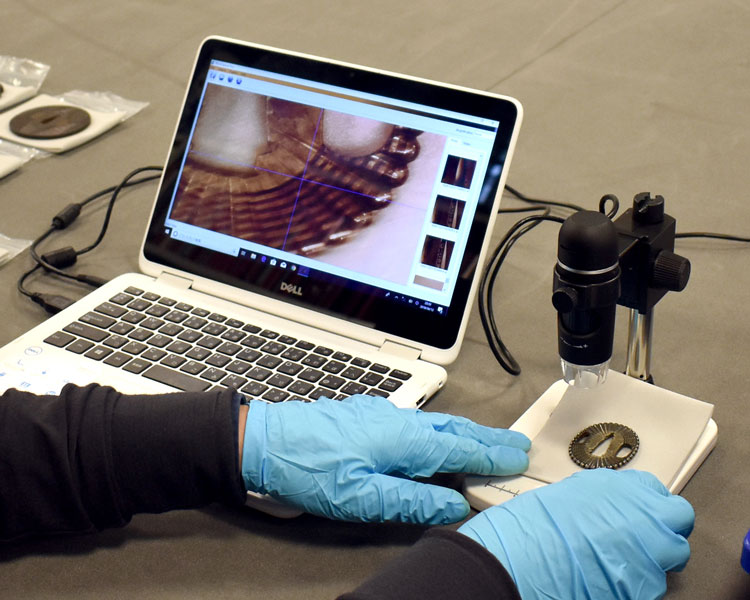
The museum has a total of 1286 tsuba, including the pieces we studied, in its collection, and the largest portion of 1264 pieces was collected by Sir Arthur H. Church (1834-1915). Born in London, he was a scientist and devoted to collecting Japanese tsuba. In his later years in particular, he collected avidly and was systematic in his approach. As a result, his collection was very complete and his texts on these tsuba have even been translated into Japanese. On this visit, we were also able to view a catalogue of the Sir Arthur H. Church tsuba collection written in 1925 by Albert James Koop (1877-1945). This is a hugely valuable work that has never been published. The contents are in English but were later bound in Japan in the Japanese “watoji” style.
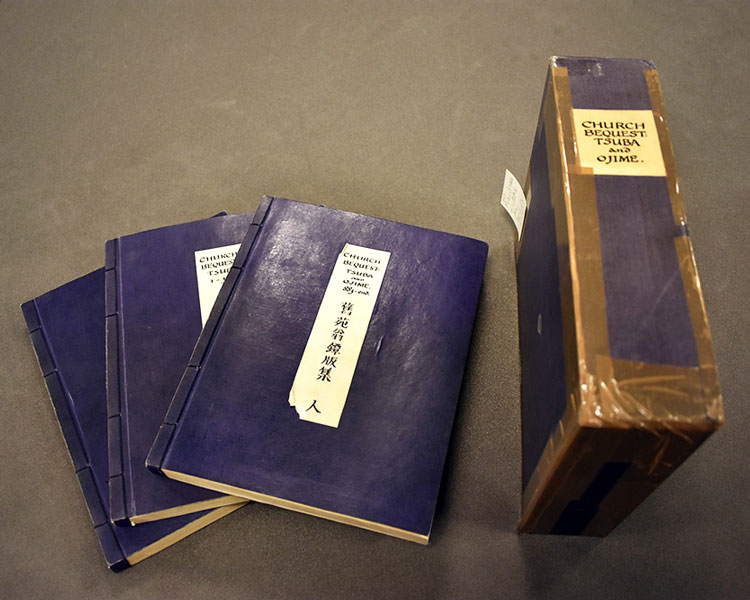
The Ashmolean Museum has an excellent website. The Eastern Art department includes, in addition to the regular collection, detailed explanations based on Koop’s catalogue. According to this, Sir Church was particularly taken with botanical and geometric designs which explains the limited number of pieces depicting people or animals.
This might explain why all of the guribori tsuba he collected were relatively unusual, with very rare pieces depicting chrysanthemum flowers not seen anywhere else.
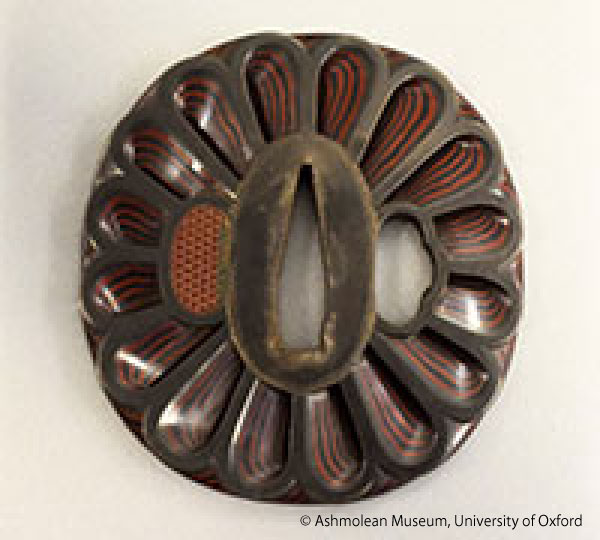
Although many round or mokkô-shaped guribori tsuba were carved with arabesques, this piece represents a three-dimensional chrysanthemum flower with the 16 petals all carved in guribori.
The lines of the layering make one think of the numerous overlapping petals of a chrysanthemum flower, and the tiny embossed pattern in the hitsuana bring to mind the heart of the flower. Even as a tsuba made for a sword, it looks really quite cute.
This piece is presented as the “chrysanthemum tsuba.” The combination of silver and shakudo is rather modern in appearance, with a very sharp design.
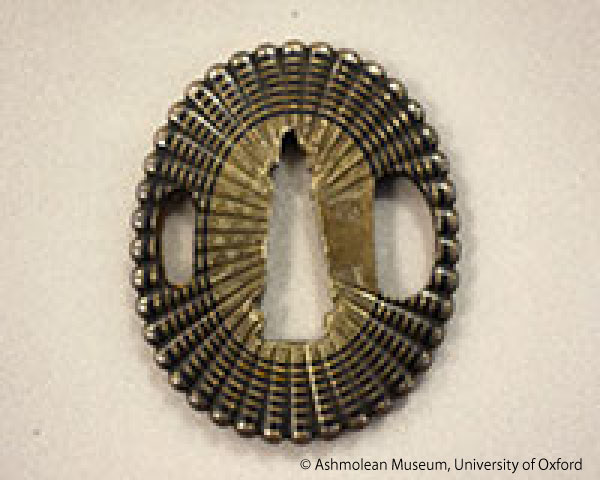
This is a guribori tsuba, but if you look closely, the entire surface of the tsuba is not covered in the arabesque patterns, the free curves are drawn in guribori carving, and the use of the two-color effect of black and red on the surface makes it a very unusual piece that shows an elegant flashiness. Looking at it with our modern eyes, it seems to be a western decorative piece and one wonders what the Edo craftsman had in mind in thinking up this “design.” Isn’t it fun to let your mind wander?
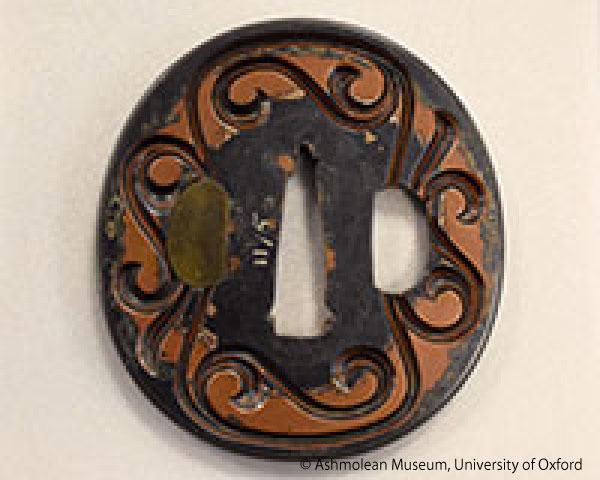
Here is the fourth guribori tsuba. Its round arabesque carvings are of a relatively commonly seen pattern.
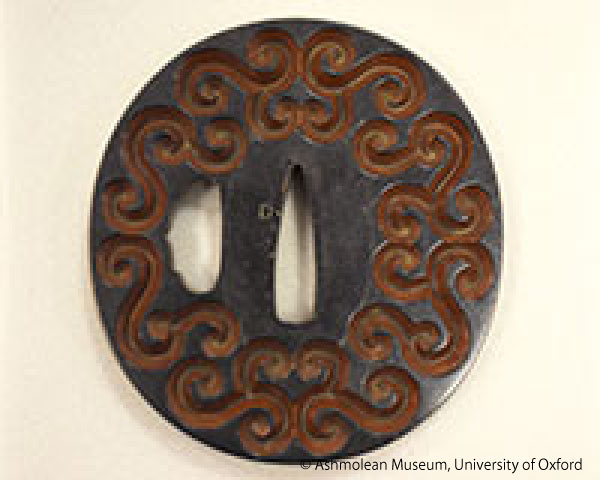
The English title for this tsuba is “Tsuba with scrolls” but in Japan, the standard term for “scrolls” or arabesques is “karakusa (palmette) pattern.” This has been used for a very long time as an auspicious decorative pattern showing entwined vine as representing vital force.
In studying these seven mokume-gane and guribori pieces on the occasion of this visit, we spent an entire day taking detailed measurements, examining the various parts closely, taking photos, looking at documentation and visiting the vaults and exhibition halls. Next time, we will tell you about our visit to the vaults and exhibition halls with curator Clare Pollard.
You will find the website of the Eeastern Art department at the Ashmolean museum here:
Mokume Gane Wedding Rings: Reddot & iF Design Award READ MORE >>
Mokume Gane Engagement Rings READ MORE >>
Mokume Gane Wedding Bands READ MORE >>


